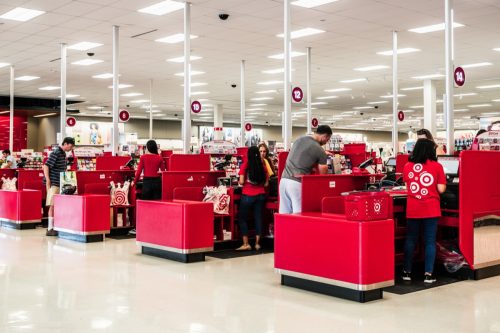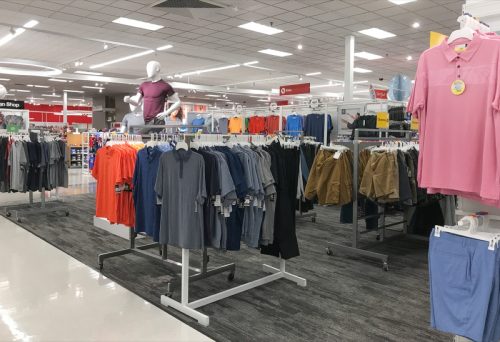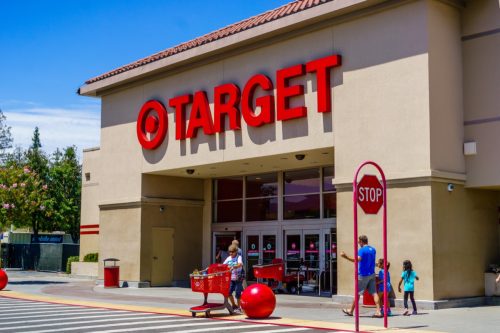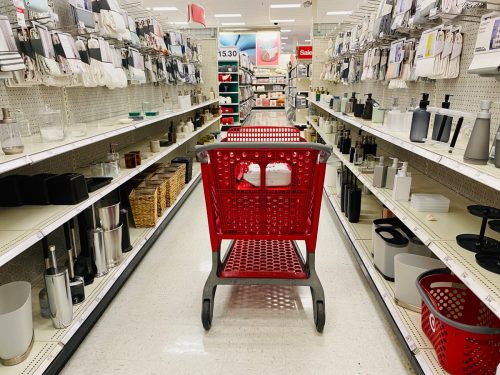Shoppers Are Still Abandoning Target—Here’s Why

Regardless of what the numbers say, Target always seems to maintain a pretty devoted following. People browse these stores for fun or even to de-stress. But while it’s often hard to resist an impulse buy or two, customers appear to be showing more restraint than usual. In recent months, data shows sales are slipping, meaning once-loyal Target shoppers are abandoning the big-box store—or at least spending less. Read on to find out what’s behind the sales slump.
RELATED: Shoppers Are Still Abandoning Home Depot, New Data Shows—Here’s Why.
Sales and revenue are down.

For 2023 as a whole, Target’s sales fell by 1.7 percent, dropping to $105.8 billion from $107.6 billion in 2022, according to a March 5 earnings release.
Annual revenue was also down for 2023, falling to $107.4 billion. This was a 1.6 percent decrease from 2022—and it’s the first time that this figure has dropped in seven years, according to The Wall Street Journal.
During the fourth quarter of 2023, specifically, Target’s comparable sales declined by 4.4 percent. This marks the third consecutive quarter that comparable sales—which includes digital sales and doesn’t factor in store openings, closings, and renovations—have dropped, CNBC reported.
In addition, while store and website traffic improved for the second quarter in a row, it was still down when compared to the same period in 2022.
RELATED: Costco Shoppers Are Abandoning These Kirkland Products: “Gone Downhill.”
Several factors contributed to the sales slip.

According to the WSJ, Target’s struggles are largely due to a pullback in discretionary spending, with customers spending less on items like home goods and electronics. Target is particularly affected by this, as it relies primarily on sales of nonfood items—unlike its competitor Walmart, which is the biggest grocer in the U.S. In fact, more than half of Target’s merchandise is comprised of non-essentials, according to CNN.
While it’s added more food to its lineup in recent years, Target’s prices are also higher than Walmart’s—on average 8.6 percent higher, CNN reported, citing an analysis performed by RBC Capital Market.
Customer criticism surrounding a line of LGBTQ Pride merchandise also contributed to falling sales, as did store theft. (However, it’s worth noting that in the fourth quarter, shrink costs—meaning those related to accidental and deliberate theft—were down when compared with the same period in 2022, per the earnings release.)
RELATED: Walmart Shoppers Say Never Buy Great Value “Ever”—Here’s Why.
Target doesn’t expect sales to improve immediately.

While it appears that shoppers have been abandoning Target, executives maintain a positive yet cautious outlook for 2024.
Target CEO and Chairman Brian Cornell emphasized that sales and traffic for the holiday season exceeded Wall Street’s predictions—and while sales aren’t going to be on the upswing immediately, there is promise for 2024.
For the current fiscal quarter, Target expects comparable sales to decline between 3 and 5 percent. For the year as a whole, the company “expects a modest increase” in this percentage, ranging from flat to 2 percent.
New initiatives are on the docket.

Target has been working to attract more customers, launching a low-priced line of everyday goods called Dealworthy last month. The company isn’t stopping there, either. As Cornell said in the earnings release, the retailer will continue to “invest in the strengths and differentiators that have delivered strong financial performance over time.”
This includes a new membership program, Target Circle, which Cornell told CNBC is “going to be a really important part of what drives growth for us as well go into next year.”
On top of that, Cornell said that Target is planning to work on improving same-day delivery to customers’ homes, allowing shoppers to get what they need in just a few hours.